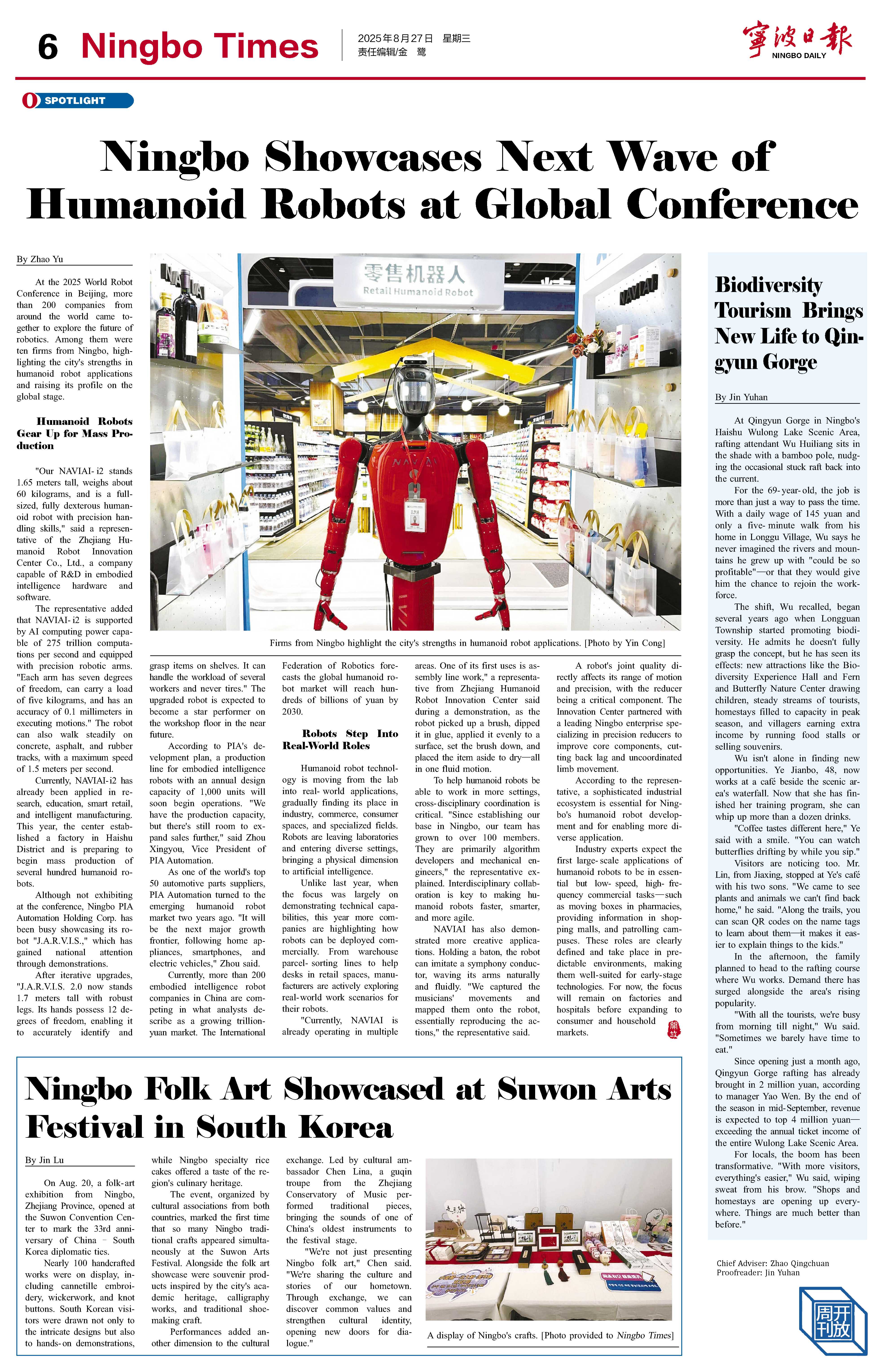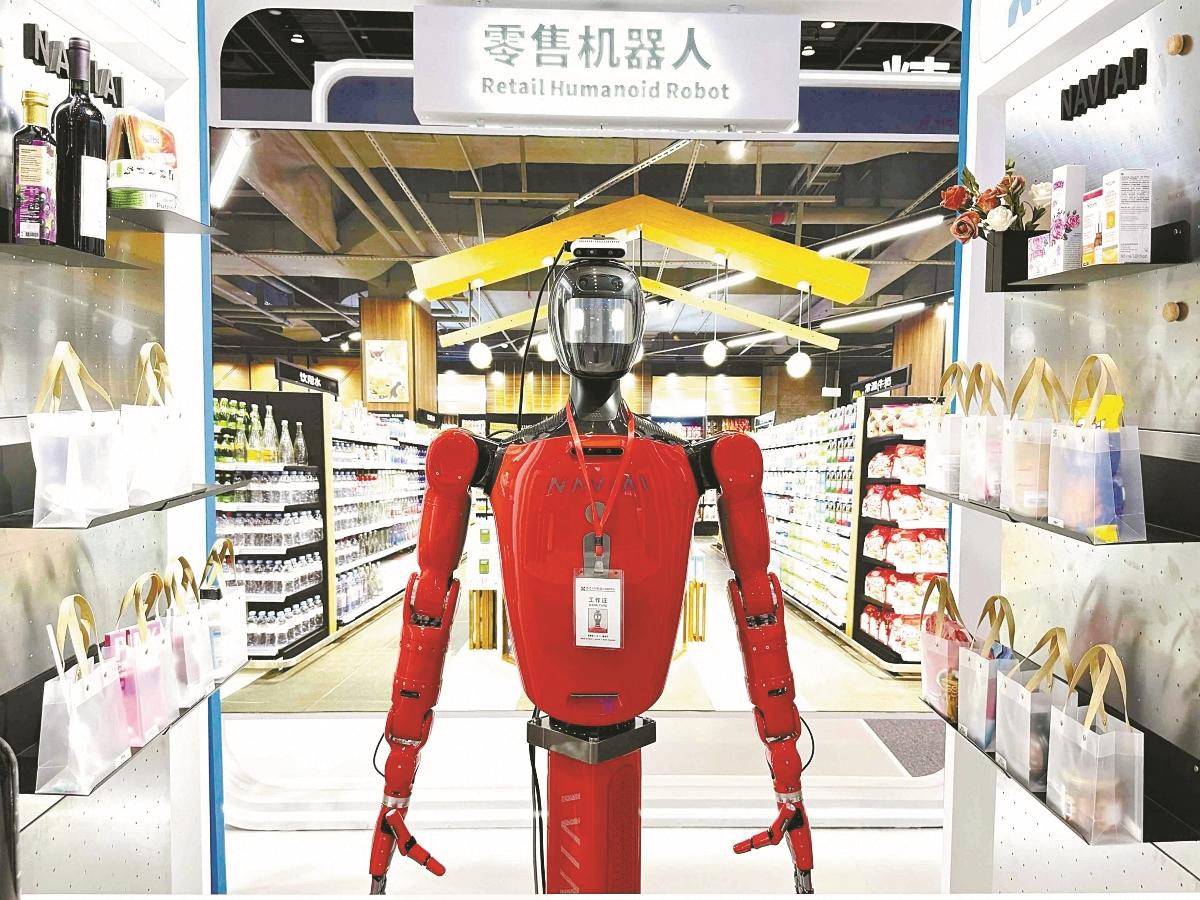By Zhao Yu
At the 2025 World Robot Conference in Beijing, more than 200 companies from around the world came together to explore the future of robotics. Among them were ten firms from Ningbo, highlighting the city's strengths in humanoid robot applications and raising its profile on the global stage.
Humanoid Robots Gear Up for Mass Production
"Our NAVIAI-i2 stands 1.65 meters tall, weighs about 60 kilograms, and is a full-sized, fully dexterous humanoid robot with precision handling skills," said a representative of the Zhejiang Humanoid Robot Innovation Center Co., Ltd., a company capable of R&D in embodied intelligence hardware and software.
The representative added that NAVIAI-i2 is supported by AI computing power capable of 275 trillion computations per second and equipped with precision robotic arms. "Each arm has seven degrees of freedom, can carry a load of five kilograms, and has an accuracy of 0.1 millimeters in executing motions." The robot can also walk steadily on concrete, asphalt, and rubber tracks, with a maximum speed of 1.5 meters per second.
Currently, NAVIAI-i2 has already been applied in research, education, smart retail, and intelligent manufacturing. This year, the center established a factory in Haishu District and is preparing to begin mass production of several hundred humanoid robots.
Although not exhibiting at the conference, Ningbo PIA Automation Holding Corp. has been busy showcasing its robot "J.A.R.V.I.S.," which has gained national attention through demonstrations.
After iterative upgrades, "J.A.R.V.I.S. 2.0 now stands 1.7 meters tall with robust legs. Its hands possess 12 degrees of freedom, enabling it to accurately identify and grasp items on shelves. It can handle the workload of several workers and never tires." The upgraded robot is expected to become a star performer on the workshop floor in the near future.
According to PIA's development plan, a production line for embodied intelligence robots with an annual design capacity of 1,000 units will soon begin operations. "We have the production capacity, but there's still room to expand sales further," said Zhou Xingyou, Vice President of PIA Automation.
As one of the world's top 50 automotive parts suppliers, PIA Automation turned to the emerging humanoid robot market two years ago. "It will be the next major growth frontier, following home appliances, smartphones, and electric vehicles," Zhou said.
Currently, more than 200 embodied intelligence robot companies in China are competing in what analysts describe as a growing trillion-yuan market. The International Federation of Robotics forecasts the global humanoid robot market will reach hundreds of billions of yuan by 2030.
Robots Step Into Real-World Roles
Humanoid robot technology is moving from the lab into real-world applications, gradually finding its place in industry, commerce, consumer spaces, and specialized fields. Robots are leaving laboratories and entering diverse settings, bringing a physical dimension to artificial intelligence.
Unlike last year, when the focus was largely on demonstrating technical capabilities, this year more companies are highlighting how robots can be deployed commercially. From warehouse parcel-sorting lines to help desks in retail spaces, manufacturers are actively exploring real-world work scenarios for their robots.
"Currently, NAVIAI is already operating in multiple areas. One of its first uses is assembly line work," a representative from Zhejiang Humanoid Robot Innovation Center said during a demonstration, as the robot picked up a brush, dipped it in glue, applied it evenly to a surface, set the brush down, and placed the item aside to dry—all in one fluid motion.
To help humanoid robots be able to work in more settings, cross-disciplinary coordination is critical. "Since establishing our base in Ningbo, our team has grown to over 100 members. They are primarily algorithm developers and mechanical engineers," the representative explained. Interdisciplinary collaboration is key to making humanoid robots faster, smarter, and more agile.
NAVIAI has also demonstrated more creative applications. Holding a baton, the robot can imitate a symphony conductor, waving its arms naturally and fluidly. "We captured the musicians' movements and mapped them onto the robot, essentially reproducing the actions," the representative said.
A robot's joint quality directly affects its range of motion and precision, with the reducer being a critical component. The Innovation Center partnered with a leading Ningbo enterprise specializing in precision reducers to improve core components, cutting back lag and uncoordinated limb movement.
According to the representative, a sophisticated industrial ecosystem is essential for Ningbo's humanoid robot development and for enabling more diverse application.
Industry experts expect the first large-scale applications of humanoid robots to be in essential but low-speed, high-frequency commercial tasks—such as moving boxes in pharmacies, providing information in shopping malls, and patrolling campuses. These roles are clearly defined and take place in predictable environments, making them well-suited for early-stage technologies. For now, the focus will remain on factories and hospitals before expanding to consumer and household markets.



